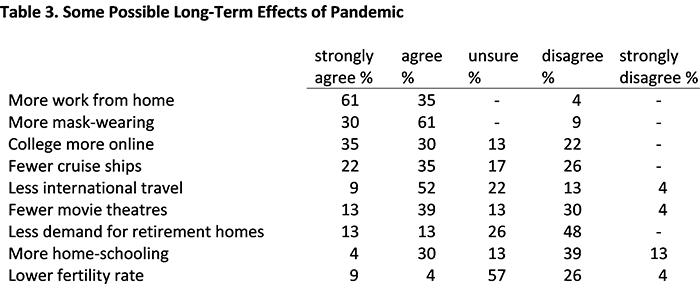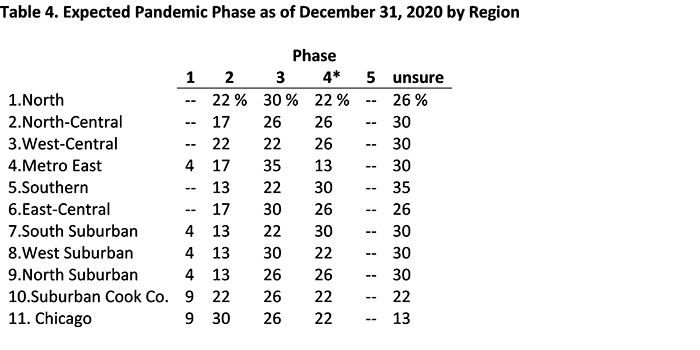
IGPA is developing several Pandemic Stress Indicators, designed to evaluate the social and economic effects of the COVID-19 pandemic on Illinois residents. The Pandemic Stress Indicators grew out of the work on IGPA’s Task Force on the Impact of the COVID-19 Pandemic.
This first stress indicator is a frequent poll of three sets of experts about pandemic policies. Experts on economics, public health, and/or vulnerable populations from across Illinois have generously agreed to provide regular opinions on various pandemic policies. The panelists, with affiliations, are listed in the full report. In answering the surveys, all panelists provide only their own personal views and do not offer official positions on behalf of their respective institutions.
Invitations to complete the sixth wave were emailed on July 29, 2020. We received 23 responses between July 29 and August 3.
How decentralized should pandemic rules be?
In mid-July, just as we launched the fifth wave of our survey, the governor altered the Restore Illinois plan by modifying metrics that dictate when a region shifts from one phase to another, and by dividing the four districts in use since the plan began in May into 11 districts. In our first survey, fielded starting May 20, we had asked respondents what is the right number of districts for pandemic policy. In light of this change, we asked a similar question again in wave six, 10 weeks later.

See Appendix for precise question wordings. Percentages of 30 respondents (May) and 23 respondents (July). The initial report on the first wave featured only 27 respondents, but we subsequently got 3 more completions, after that report was written.
In May, half of our respondents thought that four was a good number for districts permitted to adopt distinct policies, according to local conditions. The next most popular answer was five to 20, so there was some belief that four was too low. Now, with 11 districts, and thus more scope for within-state variation, the status quo is even more popular. The second most common answer in late July was uncertainty, and only one respondent would prefer more than 11 official regions. So, the switch to setting policy in the 11 Emergency Medical Services (EMS) regions seems to be broadly popular with our experts.
Statistics and Perceptions
Some recent studies have shown that general publics across multiple western democracies over-estimate both the incidence of COVID-19 (confirmed cases) and the deadliness of the disease. For instance, in one study, the mean estimated percentage of the population to have died from COVID-19 offered by American respondents was 9%, which is certainly orders of magnitude too high.[1] We asked our respondents for their impression of the accuracy of both official statistics and public perceptions of the disease, in their view. For both cases and deaths, they could choose from substantially under-estimated, substantially over-estimated, or about right.

See appendix for exact wording. N=23.
There is some inherent ambiguity in these questions, and the true values for numbers of deaths and cases are, strictly speaking, unknown. That most of our respondents regard the official count of confirmed cases as “substantially” under-estimating the true incidence is, presumably, a reflection that: some infected people are asymptomatic, and not getting tested; even some sick people are not being tested; the tests can produce false-negative results; and that such missed cases, in sum, likely exceed the number of false-positive tests.
Classifying deaths is somewhat harder than identifying infections, in the absence of a universal-post-mortem protocol. Presumably, some elderly people, perhaps especially those already in poor health, will die without ever having been tested for COVID-19, making the coding of their deaths difficult.
Media discussions sometimes distinguish between deaths directly due to COVID-19 and deaths indirectly caused by the disease, such as deaths from medical conditions not properly treated because of surging demands on hospitals and medical facilities. Our survey question (and the questions in the study cited above) leave it to the respondent to interpret whether we are asking about all deaths related to the pandemic or only deaths from the disease itself.
Most of our experts consider the official death statistics to be about right. It is interesting, in turn, that they also mostly think that the public perception of COVID-19 deaths is about right. Those who dissent were more likely to think the public is under-estimating deaths, rather than greatly over-estimating them. To be clear, the study with apparently drastic over-estimation, cited above, had a sample from across the US, not Illinois alone. Moreover, that study employed a question asking for a percentage of the population, and some of the seemingly extreme over-estimation could be a sign of respondents’ poor abilities to compute or interpret percentages.
Those of our respondents who suspect that the public is under-estimating COVID-19 deaths, meanwhile, might be inferring the direction of error from what they perceive to be reckless behavior.
Predictions
Once again, we asked respondents to make some predictions. First, looking far ahead, we asked for their reactions to some claims about how life might be changed after the COVID-19 pandemic is finally over. Table 3 shows the nine items, ordered by perceived likelihood.

N=23 for all rows (there was no non-response). See appendix for precise question wording. Items were randomly ordered in the survey.
The strongest forecast is for more working from home, even after that is no longer a medical precaution. This prediction seems in line with a fair amount of media discussion of people enjoying the flexibility of remote work, and not missing the time lost in daily commutes. Many workplaces have had to adjust procedures to allow for more remote work, and will not necessarily have incentives to undo this transformation if working at home is both popular and productive.
While many in the group think it is likely that more employees will be working from home, there was much less agreement that parents who have had to employ some degree of home schooling may stick with that approach.
Some of the possible effects the expert see as likely, such as movie theatres and the cruise-ship industry struggling, represent changes in tastes that can occur without the shock of a crisis. Retirement homes were responsible for a very disproportionate share of deaths in many states[2], but our experts were more inclined to disagree than agree that there will be a long-term drop in demand for such facilities.
Whether or not the pandemic will alter the US fertility rate—which declined steadily from about 1960 to the mid-1970s, but has been comparatively flat over recent decades[3]—was unclear to our experts.
We also asked, once again, for year-end phase forecasts. In light of the new definition of regions, we invited each respondent to project the phase for all 11 (new) regions, rather than the old four regions, as in prior waves. (The Appendix lists which counties are included in each EMS region, as did the survey question since we did not expect high levels of familiarity with the districts by number or label.) As usual, we permitted respondents to skip predictions, and many opted to do so.
Along with the high level of uncertainty, a second striking point is that nobody foresaw any region of the state reaching Phase 5 (“Illinois Restored”, i.e. the end of restrictions) by New Year’s Eve.
The status quo (Phase 4, Revitalization) was the modal response for only one region, and that was a tie at 30% each for Phase 4 and no prediction, for district 7, the southern suburbs of Chicago. Excluding the uncertain, prediction of reversion to a worse condition than Phase 4 was always more common than was prediction of staying put at Phase 4.
Moreover, six of the 11 regions were predicted to slide all the way back to Phase 1 (Rapid Spread) by at least one respondent. On the whole, it seems fair to characterize these predictions as pessimistic.

* status quo as of July 29, 2020 was Phase 4 in all regions.
N=23 for all rows
Surprises
Finally, we asked respondents to reflect on what surprised them most about the pandemic, about four months along. Many responses related to disappointment with governments and policy, at the state and national level:
“I'm surprised the governor has fallen back from his regular press conferences”;
“How the governor is too slow to impose restrictions in response to the near doubling of new cases per week”;
“borders are not closed and bars are still open”;
“the federal government does not have a solid national strategy to address this pandemic”;
“use [of] measures of the pandemic which lag, are unreliable, or are even misleading”;
“there is no plan to help working parents with childcare”;
“continuing lack of a national strategy, a continuing shortage of PPE and testing availability, and that wearing a mask has become politicized.”
Other responses focused somewhat more on public attitudes and behaviors. Some echoed surprise that mask wearing has become politicized and controversial, and were dismayed by the insouciance of people “so quick to return to large gatherings” and by “the extent to which a public health issue has been turned into a tool for partisan divides and election politics.”
The only surprise that was framed around disease, more than policy (as such), was “just how large this ‘second wave’ has been.”
We asked respondents for “surprises,” but one respondent, possibly speaking for others too, clarified, “I am surprised and not surprised - perhaps disheartened is a better word.”
Appendix: Precise Questions Wording
Q1. The "Restore Illinois" plan introduced in May grouped 11 Emergency Medical Services regions into 4 larger regions (Northeast, North-Central, Central, and Southern Illinois) that could follow different mitigation plans, according to public-health statistics. Recently, the plan was revised so that the 11 regions will now be assessed separately, with policies in each allowed to diverge, to follow local conditions. What do you think is the right number of regions for pandemic rules in Illinois?
Q2. People have altered many aspects of their lives in recent months, temporarily staying at home to a reduce exposure to COVID-19. Looking ahead to when the pandemic is finally over, which, if any, of the following long-term effects of these shifts do you foresee?
Response options were “strongly agree”, “agree”, “unsure”, “disagree”, and “strongly disagree”. Non-response was also permitted. The individual items thus rated were randomly ordered and read:
Many people will continue to work at home more than they used to before COVID-19.
Many parents will continue home schooling their children, including online learning.
College and university teaching will stay online to a much greater extent than ever before.
Movie theaters will struggle to regain audiences.
International travel will not return to pre-pandemic levels for years.
Wearing masks for protection against infectious disease will be much more common.
Demand for places in retirement homes and assisted-living facilities will fall.
The popularity of cruise ships will not recover to old levels.
The US fertility rates will slump further, below pre-COVID-19 trends.
Q3. What surprises you most about current conditions, a little more than four months after the mid-March Gubernatorial Disaster Proclamation "in response to the ongoing Coronavirus (COVID-19) situation"?
Q4. Do you think that official COVID-19 statistics for Illinois are accurate reflections of the disease's true incidence and impact, or are prone to substantial error?
[We offered three responses, “substantially under-estimate incidence”, “pretty accurate”, and “substantially over-estimate incidence” for 2 prompts, “cases” and “deaths.”]
Q5 followed exactly the same format, only asking about “public perceptions of COVID-19 in Illinois” rather than official statistics.
Q6. We remain interested in your medium-to-long-term phase forecasts. How do you think the 11 regions of the state, as defined by Restore Illinois, will look on December 31, 2020, (As always, you can skip a row if you are not comfortable making a prediction for that area.)
Response options were arranged with phases as columns and districts as rows. Columns included the labels attached to each phase, I,e, “Phase 1 (Rapid Spread)”; “Phase 2 (Flattening)”; “Phase 3 (Recovery)”; Phase 4 (Revitalization)”; and “Phase 5 (Illinois Restored)”.
1. NORTH: Boone, Carroll, DeKalb, Jo Daviess, Lee, Ogle, Stephenson, Whiteside, Winnebago
2. NORTH-CENRAL: Bureau, Fulton, Grundy, Henderson, Henry, Kendall, Knox, La Salle, Livingston, Marshall, McDonough, McLean, Mercer, Peoria, Putnam, Rock Island, Stark, Tazewell, Warren, Woodford
3. WEST-CENTRAL: Adams, Brown, Calhoun, Cass, Christian, Greene, Hancock, Jersey, Logan, Macoupin, Mason, Mason, Menard, Montgomery, Morgan, Pike, Sangamon, Schuyler, Scott
4. METRO EAST: Bond, Clinton, Madison, Monroe, Randolph, St. Clair, Washington
5. SOUTHERN: Alexander, Edwards, Franklin, Gallatin, Hamilton, Hardin, Jackson, Jefferson, Johnson, Marion, Massac, Perry, Pope, Pulaski, Saline, Union, Wabash, Wayne, White, Williamson
6. EAST-CENTRAL: Champaign, Clark, Clay, Coles, Crawford, Cumberland, De Witt, Douglas, Edgar, Effingham, Fayette, Ford, Iroquois, Jasper, Lawrence, Macon, Moultrie, Piatt, Richland, Shelby, Vermillion
7. SOUTH SUBURBAN: Kankakee, Will
8. WEST SUBURBAN: DuPage, Kane
9. NORTH SUBURBAN: Lake, McHenry
10. SUBURBAN COOK: Suburban Cook
11. CHICAGO: City of Chicago
[1] See July 27 report “ https://www.kekstcnc.com/media/2793/kekstcnc_research_covid-19_opinion_tracker_wave-4.pdf,section 12. The US population is about 330 million and the official estimate for number of COVID-19 deaths is about 157,000 at time of writing. Allowing that both are merely estimates, the mean answer of 9% appears to be roughly in the vicinity of 200 times too high.
[2] See, e.g, Greg Girvan, “Nursing Homes & Assisted Living Facilities Account for 45% of COVID19 Deaths” FreOpp, accessed August 3, 2020 at https://freopp.org/the-covid-19-nursing-home-crisis-by-the-numbers-3a474....
[3] See, e.g. https://www.statista.com/statistics/1033027/fertility-rate-us-1800-2020/
Some recent studies have shown that general publics across multiple western democracies over-estimate both the incidence of COVID-19 (confirmed cases) and the deadliness of the disease.